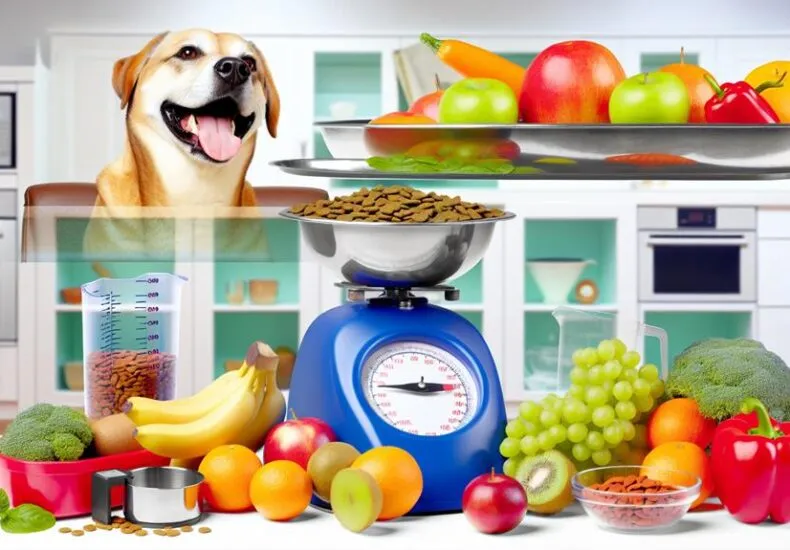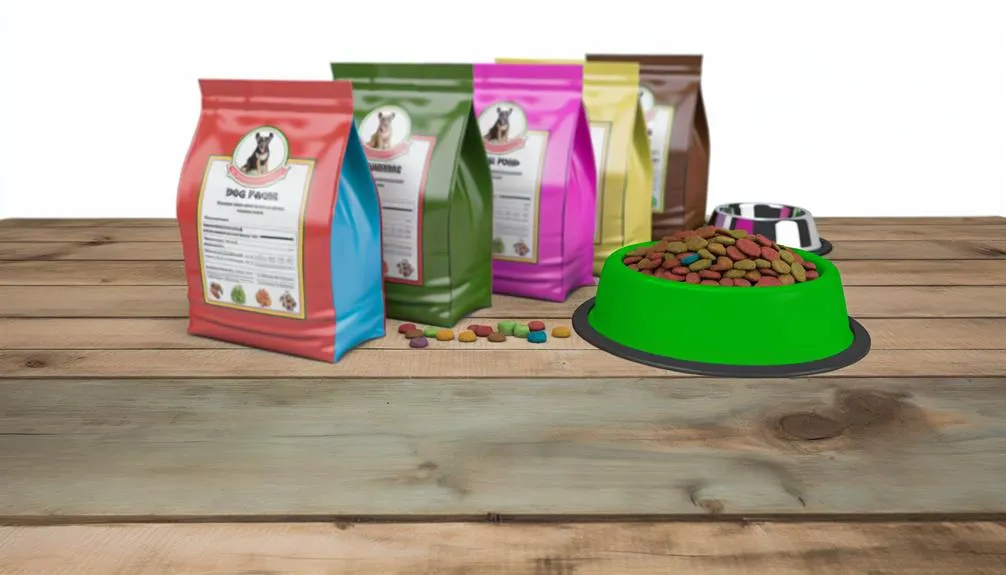
How Much to Feed a Dog
Like the careful balance of a well-composed symphony, feeding your dog requires attention to various notes—age, weight, and activity level. You might think a simple scoop of kibble is enough, but it's not always that straightforward. Understanding the intricacies of portion sizes and caloric needs can be essential for your pet's health. What if you're underestimating or overestimating their requirements? Exploring the right approach could mean the difference between a thriving dog and one at risk of health issues.
Factors Affecting Dog Nutrition
When considering how much to feed your dog, it's vital to understand the various factors that affect their nutritional needs. These factors include age, weight, activity level, and breed. Puppies, for example, have higher energy requirements than adult dogs, necessitating more frequent meals to support their growth. Similarly, a highly active dog will require more calories than a sedentary one, so analyzing your dog's lifestyle is essential in determining their feeding schedules.
Another important consideration is the dog's weight. If your dog is overweight, you'll need to adjust their portions to promote weight loss, whereas underweight dogs may need increased feeding amounts to gain healthy weight. Additionally, certain breeds have specific dietary needs; for instance, large breeds may require different nutrients than small breeds to support their bone health and overall well-being.
Health conditions can also heavily influence your dog's nutritional needs. Dogs with allergies or sensitivities may need special diets, while older dogs might benefit from food formulated for senior pets, which often contains joint-supporting ingredients.
Lastly, always consider the quality of food you're providing. Higher-quality dog foods typically offer better nutritional value, which can impact how much you need to feed your dog. By carefully evaluating these factors and creating appropriate feeding schedules, you can guarantee that your dog receives the right amount of nutrition for a healthy and active life.
Recommended Daily Caloric Intake
Determining your dog's recommended daily caloric intake is essential for maintaining their health and well-being. Every dog has unique needs based on factors like age, weight, activity level, and overall health. To guarantee you're meeting these needs, it's important to calculate their caloric intake accurately.
Here's a simple guide to help you understand the different caloric needs based on your dog's lifestyle:
| Activity Level | Daily Caloric Intake (per 10 lbs) |
|---|---|
| Sedentary | 200 calories |
| Moderately Active | 250 calories |
| Highly Active | 300 calories |
Caloric density plays a significant role in how much food your dog actually requires. Foods with high caloric density provide more calories in smaller portions, which can be beneficial for less active dogs. Conversely, if your dog is more active, they'll likely need a food with lower caloric density to sustain their energy levels without overfeeding.
Establishing a consistent feeding schedule is crucial as well. Regular feedings help regulate your dog's metabolism and can prevent overeating. Monitor their weight and adjust the caloric intake as needed, making sure they remain at a healthy weight.
Understanding Dog Food Labels

Interpreting dog food labels can be intimidating, but understanding them is essential for making informed dietary choices for your furry friend. When you look at a dog food label, the first thing you should do is check the ingredients list. Ingredients are typically listed in descending order by weight, so the first few items are the most significant. Look for high-quality protein sources like chicken or beef as the primary ingredients, rather than fillers like corn or soy.
Next, pay attention to the nutritional analysis provided on the label. This section breaks down the percentages of protein, fat, fiber, and moisture in the food. A good rule of thumb is to aim for a balance that meets your dog's specific needs based on age, activity level, and health status. For example, active dogs may require higher protein and fat content to sustain their energy levels.
Also, watch for any added vitamins and minerals. These can enhance your dog's diet and guarantee they're getting a well-rounded nutritional profile. However, be cautious of labels that make vague claims like "natural" or "premium" without providing clear details. Always look for food that meets the standards set by the Association of American Feed Control Officials (AAFCO), which guarantees the food is complete and balanced.
Portion Sizes by Dog Size
When determining how much to feed your dog, it's crucial to take into account their size. Small breeds typically require smaller portions, while large breeds need more substantial amounts to meet their energy needs. Understanding these guidelines can help guarantee your dog maintains a healthy weight and receives the proper nutrition.
Small Breeds Guidelines
Feeding small breed dogs requires careful attention to portion sizes, as their nutritional needs differ markedly from larger breeds. For small breeds, portion control is crucial to prevent obesity and related health issues. Generally, a small dog weighing around 5 to 10 pounds should receive about 1/2 to 1 cup of high-quality dog food daily, divided into two or three meals.
When it comes to puppy nutrition, small breed puppies need more calories per pound than their larger counterparts. You should feed them a specially formulated puppy food that promotes healthy growth. For puppies weighing up to 5 pounds, 1/4 to 1/2 cup of food per day is appropriate, while those weighing between 5 to 10 pounds can handle 1/2 to 1 cup daily.
Always consult your veterinarian to tailor the feeding amount to your dog's specific needs, considering factors like age, activity level, and metabolism. Additionally, choose dog food that lists meat as the first ingredient and meets AAFCO standards for complete and balanced nutrition. This approach guarantees that you're practicing effective small breed feeding, supporting your dog's health and longevity.
Large Breeds Recommendations
Large breed dogs have unique nutritional requirements that reflect their size and growth patterns. Proper feeding is essential to prevent health issues like obesity and joint problems. When determining how much to feed your large breed dog, consider their age, weight, and activity level. Here are some general recommendations:
- Puppies (up to 12 months): Feed 3-4 meals per day, totaling 25-30 calories per pound of body weight.
- Young adults (1-3 years): Shift to 2 meals per day, offering around 20-25 calories per pound.
- Mature adults (3-7 years): Maintain 2 meals per day, with portions adjusting to around 18-22 calories per pound.
- Seniors (7+ years): Continue with 2 meals per day, focusing on lower-calorie diets if weight gain occurs.
Establishing consistent feeding schedules helps regulate your dog's appetite and supports digestive health. Always consult your veterinarian for personalized recommendations based on your dog's specific needs. By paying attention to portion sizes and proper feeding routines, you'll contribute to your large breed dog's overall well-being and longevity.
Adjusting Portions for Activity Level

Adjusting your dog's food portions based on their activity level is crucial for maintaining a healthy weight and ensuring ideal energy levels. Different dogs have varying activity levels, from couch potatoes to high-energy athletes, and their nutritional needs should reflect that. If your dog leads a more sedentary lifestyle, you'll want to reduce their portion sizes to prevent weight gain. Conversely, a highly active dog may require additional calories to fuel their energy expenditure.
To make appropriate feeding adjustments, start by evaluating your dog's daily activity. If they engage in regular exercise, such as walks, playtime, or agility training, increase their food portions accordingly. On the other hand, if your dog spends most of the day lounging, consider providing a smaller meal to maintain their weight. Keep in mind that a dog's activity level can change seasonally or with age, so it's important to reevaluate their needs periodically.
You can also use a calorie calculator or consult your veterinarian to determine the right amount of food based on your dog's specific activity level and overall health. Remember, it's not just about quantity; the quality of food also matters. Opt for a balanced diet that supports your dog's energy needs without excess fillers. By adjusting portions appropriately, you'll help your dog stay fit, healthy, and happy, ensuring they have the energy to enjoy their daily activities to the fullest.
Signs of Proper Feeding
Recognizing the signs of proper feeding is essential to guaranteeing your dog remains healthy and happy. When you maintain the right feeding frequency and meal timing, you'll notice several key indicators that suggest your dog is thriving. Here are some signs to look for:
- Consistent Energy Levels: A well-fed dog should have stable energy throughout the day, not experiencing sudden spikes or drops.
- Healthy Coat and Skin: A shiny, soft coat and healthy skin are signs of good nutrition. If you notice excessive shedding or dull fur, it may indicate dietary issues.
- Normal Weight Maintenance: Your dog should maintain a healthy weight, showing neither obesity nor being underweight. Regularly check their body condition to guarantee they're within the ideal range.
- Regular Bowel Movements: Healthy feeding habits lead to consistent and firm bowel movements. Irregularity can signal dietary problems, such as overfeeding or poor-quality food.
Pay attention to these signs, as they reflect the effectiveness of your dog's feeding routine. If you notice any changes, consider adjusting feeding frequency or meal timing. Remember, every dog is different, and their needs can change based on factors like age, activity level, and health. By being observant, you'll guarantee your canine companion receives the nutrition they need to lead a vibrant and active life.
Frequently Asked Questions
Can I Mix Different Dog Food Brands Together?
Yes, you can mix different dog food brands. Just verify the combined foods meet feeding guidelines for balanced nutrition. Gradually introduce the mix to avoid digestive upset, observing your dog's response throughout the change.
How Often Should I Change My Dog's Food?
Changing your dog's food is like revitalizing a garden; it needs care. Aim for a gradual changeover over seven days, aligning with your feeding schedule. Consistency helps maintain your pup's digestive harmony and happiness.
Is It Safe to Feed My Dog Table Scraps?
Feeding your dog table scraps can be risky for dog health. Many human foods aren't safe for dogs, leading to digestive issues or toxicity. Always check which scraps are safe and consult your vet for guidance.
What Should I Do if My Dog Refuses to Eat?
When your dog suddenly refuses to eat, it's concerning. Consider possible appetite causes, like stress or health issues. Adjusting their feeding schedule might help spark interest in food again. Always consult your vet if it persists.
Are There Specific Foods to Avoid for Certain Breeds?
Yes, certain breeds may require breed-specific diets. You should avoid common allergens like wheat, soy, and dairy, as these can trigger sensitivities in some dogs. Always consult your vet to tailor the best diet for your pet.
Conclusion
In summary, finding the right amount to feed your dog is essential for their health and happiness—after all, a well-fed dog is as happy as a kid in a candy store! By considering factors like age, weight, and activity level, you can guarantee your furry friend gets the nutrition they need. Regularly monitoring their weight and consulting with a veterinarian will help you make informed decisions, keeping your pup thriving and full of life.
You may also like
Archives
Calendar
| M | T | W | T | F | S | S |
|---|---|---|---|---|---|---|
| 1 | 2 | 3 | 4 | 5 | 6 | |
| 7 | 8 | 9 | 10 | 11 | 12 | 13 |
| 14 | 15 | 16 | 17 | 18 | 19 | 20 |
| 21 | 22 | 23 | 24 | 25 | 26 | 27 |
| 28 | 29 | 30 | ||||
Leave a Reply